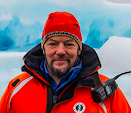Icebound in the Arctic:
The Mystery of Captain Francis Crozier and the Franklin Expedition
by Michael Smith
Dublin: The O'Brien Press, 2021
$22.99 (US), £12.16 (UK), €20.67 (EU)
The chapters and sections here build on those of the original edition; the original chapters are both updated and augmented, and new chapters have been added. There's also a fair amount of new illustrative material -- after all, the book would seem incomplete without (for example) a photograph of Crozier's desk, as found by Parks Canada's ROV. The only known photograph of Lady Franklin -- which I uncovered in 2012 -- is also reproduced here. Another welcome addition is the image of the alabaster bust of Crozier sculpted in Florence in 1845, but not hitherto published. And lastly, most -- though not quite all -- of the excellent maps are retained, with a new one, showing the locations at which both ships were found, added.
There's no better portrait of Francis Crozier than the one Smith gives us -- with all his bright and cloudy moments interwoven. At the same time, there are aspects of his life and achievements that seem contradictory -- he had enormous energy and tenacity, his brilliant scientific work -- and yet he also had his bouts of melancholy, his reluctance to be first-in-command. Smith's approach to this is to take each of the various issues ad sertiatim, relying on alternating dark and light strokes in his assessment of Crozier's character.
This strategy works admirably, although personally I felt that some of the darker strokes have too grim a feel to them -- I felt this particularly in Chapter 14, 'I Am Not Equal to the Hardship." This phrase comes from one of Crozier's letters, and the key word, "hardship," can also be interpreted as "leadership." It certainly makes, I think, more sense as "leadership," since Crozier in his letters to James Clark Ross when he volunteered his services sounds enthusiastic and confident. The hardship would have been the same no matter what his position, and certainly he knew of it and accepted it; his ability to lead was what he doubted. And of course, the final irony was that, scarcely two years into their voyage, the death of Franklin propelled him to the leadership of the expedition anyway.
The major new chapter is the last, "Lost and Found," which recounts, as promised on the cover, the "sensational discovery of the ships." It's a dramatic and succinct account, and the best so far to have appeared in book form. My only criticism is that Smith assumes both ships drifted, unpiloted, to their respective positions; we do not yet have firm evidence one way or another, and stating it as simple fact obscures this important uncertainty. Certainly with the Terror, neatly parked in what later became its eponymous bay, there's some thought that she was directed to this safer harbor by Crozier himself.
It's in this last chapter, only, that I missed somewhat the presence of color in the illustrations; in black-and-white, Crozier's desk seems blurry rather than draped, as it is, in the greenish murk of the captain's great room. But this is a minor criticism; all the many merits of the original edition are here, and there are numerous improvements and expansions.
So let us welcome this new edition, and the strong, contrasted portrait of Crozier's career that it brings. It bears clear witness to (as the Crozier memorial in Banbridge puts it) to his "unbending integrity and truthfulness" as well as to his "extreme amiability"-- and, as was Crozier himself, Smith's book is very good company indeed.


